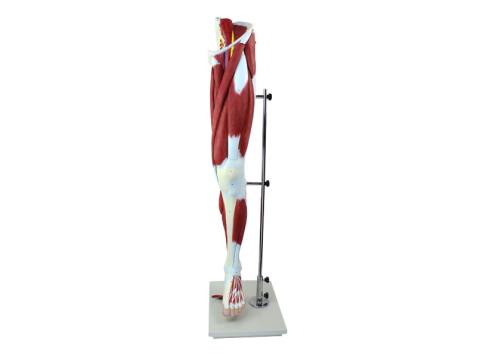

Article tag: Lower limb muscle anatomy model| muscle anatomy model|
The anatomical model of lower limb muscle plays a vital role in medical education, rehabilitation training, sports science and clinical practice. Here are some of the main reasons why an anatomical model of the lower limb muscles is nee...
The anatomical model of lower limb muscle plays a vital role in medical education, rehabilitation training, sports science and clinical practice. Here are some of the main reasons why an anatomical model of the lower limb muscles is needed:
The muscle system of lower limb is complex and diverse, including many muscle groups such as thigh muscle, calf muscle and foot muscle, as well as the intricate connection relationship between them. Through the three-dimensional form, it can intuitively and accurately show the shape, position, starting and ending point of these muscles and the correlation between them. This kind of visual display helps learners to quickly establish the overall cognition of the lower limb muscle system and improve the learning efficiency.

In medical education and rehabilitation training, the study of theoretical knowledge often needs to be combined with practical operation to deeply understand and master. It provides a platform for learners to simulate practice. Through simulated anatomy, surgical operation, rehabilitation training and other exercises on the model, learners can transform theoretical knowledge into practical skills and deepen their understanding of muscle function, motor mechanism and injury repair.
The lower limb muscle anatomy model can be customized to the needs and levels of different learners. In medical education, teachers can choose suitable models to explain and demonstrate according to the course content and students' characteristics; In rehabilitation training, therapists can develop personalized rehabilitation programs according to the specific conditions of patients, and with the help of models for demonstration and guidance. This personalized teaching method and rehabilitation guidance are helpful to improve the teaching effect and rehabilitation quality.
Models can also be an effective educational tool for patients. Through the demonstration and explanation of the model, patients can better understand their own muscle system and its role in the process of exercise and injury repair, and enhance the understanding and cooperation of treatment programs. At the same time, patients can also use the model to conduct self-rehabilitation training guidance and improve self-rehabilitation ability.
To sum up, the anatomical model of lower limb muscle plays an irreplaceable role in medical education, rehabilitation training, sports science and clinical practice. It can not only visually display complex structures, promote the combination of theory and practice, but also realize personalized teaching and rehabilitation guidance, promote interdisciplinary communication and cooperation, and enhance the ability of patient education and self-rehabilitation.